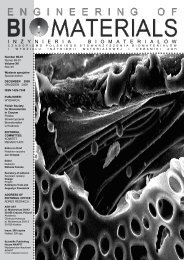62 - Polskie Stowarzyszenie BiomateriaÅów
62 - Polskie Stowarzyszenie BiomateriaÅów
62 - Polskie Stowarzyszenie BiomateriaÅów
Create successful ePaper yourself
Turn your PDF publications into a flip-book with our unique Google optimized e-Paper software.
5<br />
FIG. 3. SEM picture of PBT/DLA/PEG 1000 materials.<br />
a) PEE, b) PEE/VE, c) PEE/HAP I, d) PEE/HAP I/VE, e) PEE/HAP III, f) PEE/HAP III/VE<br />
The basic challenge with the use of HAP nanoparticles<br />
in TPE is the nanoreinforcement through development of<br />
a “second” physical network. According to the main principle<br />
of the elastothermoplastic character of multiblock copolymers,<br />
at least one of the blocks has to be a soft (low T g ) material,<br />
such as a polyether in segmented poly(ether–ester)s<br />
or polyester in segmented poly(ester–amide)s. The second<br />
component must consist of a high T g or T m hard segment,<br />
and the hard and soft segments have to be chosen such that<br />
the free energy of mixing is positive [6]. Thus, the mutual<br />
incompatibility of the segments induces microphase separation<br />
in the solid state. A common tool to determine changes,<br />
such as phase segregation, glass transitions, and melting,<br />
is a differential scanning calorimetry (DSC).













